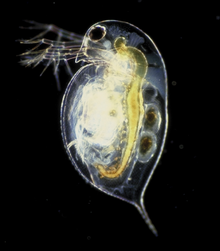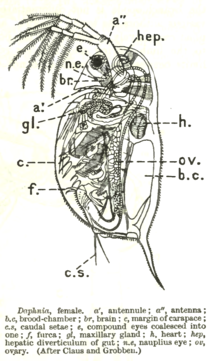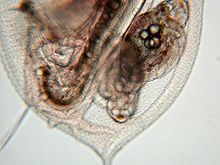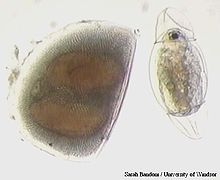- Daphnia
-
Daphnia 
Daphnia pulex Scientific classification Kingdom: Animalia Phylum: Arthropoda Subphylum: Crustacea Class: Branchiopoda Order: Cladocera Family: Daphniidae Genus: Daphnia
Müller, 1785Species - Subgenus Daphnia
- Daphnia ambigua
- Daphnia arenata
- Daphnia catawba
- Daphnia cheraphila
- Daphnia latispina
- Daphnia melanica
- Daphnia middendorffiana
- Daphnia minnehaha
- Daphnia neo-obtusa
- Daphnia obtusa
- Daphnia oregonensis
- Daphnia parvula
- Daphnia pileata
- Daphnia prolata
- Daphnia pulex
- Daphnia pulicaria
- Daphnia retrocurva
- Daphnia tanakai
- Daphnia tenebrosa
- Daphnia villosa
- Subgenus Hyalodaphnia
- Daphnia curvirostris
- Daphnia dentifera
- Daphnia dubia
- Daphnia galeata
- Daphnia lacustris
- Daphnia laevis
- Daphnia longiremis
- Daphnia longispina
- Daphnia mendotae
- Daphnia thorata
- Daphnia umbra
- Subgenus Ctenodaphnia
- Daphnia barbata
- Daphnia brooksi
- Daphnia ephemeralis
- Daphnia exilis
- Daphnia lumholtzi
- Daphnia magna
- Daphnia salina
- Daphnia similis
Daphnia are small, planktonic crustaceans, between 0.2 and 5 mm in length. Daphnia are members of the order Cladocera, and are one of the several small aquatic crustaceans commonly called water fleas because of their saltatory swimming style (although fleas are insects and thus only very distantly related). They live in various aquatic environments ranging from acidic swamps to freshwater lakes, ponds, streams and rivers.
Contents
Appearance and characteristics
The division of the body into segments is not visible. The head is fused, and is generally bent down towards the body with a visible notch separating the two. In most species the rest of the body is covered by a carapace, with a ventral gap in which the five or six pairs of legs lie. The most prominent features are the compound eyes, the second antennae, and a pair of abdominal setae. In many species, the carapace is translucent or nearly so and as a result they make excellent subjects for the microscope as one can observe the beating heart.
Even under relatively low power microscopy, the feeding mechanism can be observed, with immature young moving in the brood-pouch; moreover, the eye being moved by the ciliary muscles can be seen, as well as blood corpuscles being pumped around the circulatory system by the simple heart. The heart is at the top of the back, just behind the head, and the average heart rate is approximately 180 bpm under normal conditions. Daphnia, like many animals, are prone to alcohol intoxication, and make excellent subjects for studying the effects of the depressant on the nervous system – due to the translucent exoskeleton, and the visibly altered heart rate. They are tolerant of being observed live under a cover slip and appear to suffer no harm when returned to open water. This experiment can also be done using caffeine, nicotine or adrenaline and observing an increase in heart rate.
Systematics and evolution
Daphnia is a large genus comprising about 150 species, belonging to the cladoceran family Daphniidae. It is subdivided into several subgenera (Daphnia, Hyalodaphnia, Ctenodaphnia), but the division has been controversial and is still in developmental phase. Each subgenus has been further divided into a number of species complexes. The understanding of species boundaries has been hindered by phenotypic plasticity, hybridization, intercontinental introductions and poor taxonomic descriptions.[1][2][3]
Reproduction
Daphnia reproduce parthenogenetically usually in the spring until the end of the summer. One or more juvenile animals are nurtured in the brood pouch inside the carapace. The newly hatched Daphnia must molt several times before they are fully grown into an adult usually after about two weeks. The young are small copies of the adult; there are no true nymphal or instar stages. The fully mature females are able to produce a new brood of young about every ten days under ideal conditions. The reproduction process continues while the environmental conditions continue to support their growth. When winter approaches or in drought conditions or at times of other harsh environmental conditions, production of new female generations cease and parthenogenic males are produced. However, even in harsh environmental conditions males may make up considerably less than half the population, in some species they are unknown entirely. Males are much smaller in size than the female and they typically possess a specialized abdominal appendage which is used in mating to grasp a female from behind, pries open her carapace, insert a spermatheca, and thus fertilize the eggs.
These fertilized eggs are termed winter eggs and are provided with extra shell layer called ephippium. The extra layer preserves and protects the egg inside from harsh environmental conditions until the more favourable times, such as spring, when the reproductive cycle is able to take place once again.
In addition to the production of eggs capable of overwintering, this switch to sexual reproduction has also been proposed to allow greater offspring variation (through genetic recombination) which may be useful in varied or unpredictable conditions, this idea is often proposed under the name of the lottery model.
Lifespan
The lifespan of a Daphnia does not exceed one year and is largely temperature dependent. For example, individual organisms can live up to 108 days at 3 °C (37 °F) while some organisms live for only 29 days at 28 °C (82 °F). A clear exception to this trend is during the winter time in which harsh conditions limit the population in which females have been recorded to live for over six months. These females generally grow at a slower rate but in the end are larger than ones under normal conditions.
Ecology
Several Daphnia species are considered threatened. The following are listed as vulnerable by IUCN: Daphnia nivalis, Daphnia coronata, Daphnia occidentalis, and Daphnia jollyi. Some species are halophiles, and can be found in hypersaline lake environments, an example of which is the Makgadikgadi Pan.[4]
Daphnia may sometimes ingest tiny crustaceans and rotifers, but usually they are filter feeders, ingesting mainly unicellular algae and various sorts of organic detritus including protists and bacteria. They can gather detritus not only from water column, but also from the bottom of lakes (especially in winter) or laboratory enclosures. Daphnia can be kept easily on a diet of yeast, but this occurs mostly in laboratories or controlled environments. Beating of the legs produces a constant current through the carapace which brings such material into the digestive tract. The trapped food particles are formed into a food bolus which then moves down the digestive tract until voided through the anus located on the ventral surface of the terminal appendage. The first and second pair of legs are used in the organisms' filter feeding ensuring large un-absorbable particles are kept out while the other sets of legs create the stream of water rushing into the organism.
Swimming is powered mainly by the second set of antennae which are larger in size than the first set. The action of this second set of antennae is responsible for the jumping motion.
Uses
Sometimes Daphnia may be used in certain environments to test the effects of toxins on an ecosystem. This makes Daphnia an indicator species, particularly useful in that area because of its short lifespan and reproductive capabilities. Because they are nearly transparent, their internal organs are easy to study in live specimens (an example might be to study the effect of temperature on the heart rate of these ectothermic organisms). They are often fed to tadpoles or small species of amphibians such as the African Dwarf Frog (Hymenochirus biettgeri). Daphnia are also a popular live food in tropical and marine fish keeping.[5]
References
- ^ Niles Lehman, Michael E. Pfrender, Phillip A. Morin, Teresa J. Crease and Michael Lynch (1995). "A hierarchical molecular phylogeny within the genus Daphnia". Molecular Phylogenetics and Evolution 4 (4): 395–407. doi:10.1006/mpev.1995.1037. PMID 8747296.
- ^ Derek J. Taylor, Paul D. N. Hebert & John K. Colbourne (1996). "Phylogenetics and evolution of the Daphnia longispina group (Crustacea) based on 12S rDNA sequence and allozyme variation" (PDF). Molecular Phylogenetics and Evolution 5 (3): 495–510. doi:10.1006/mpev.1996.0045. PMID 8744763. http://www.buffalo.edu/~djtaylor/publications_files/Tayloretal1996.pdf.
- ^ Sarah J. Adamowicz, Paul D. N. Hebert & María Christina Marinone (2004). "Species diversity and endemism in the Daphnia of Argentina: a genetic investigation". Zoological Journal of the Linnean Society 140 (2): 171–205. doi:10.1111/j.1096-3642.2003.00089.x.
- ^ C. Michael Hogan (2008). "Makgadikgadi". The Megalithic Portal. http://www.megalithic.co.uk/article.php?sid=22373&mode=&order=0.
- ^ "The amazing Daphnia water flea". AquaDaily. February 16, 2009. http://aquadaily.com/2009/02/16/the-amazing-daphnia-water-flea/. Retrieved February 18, 2009.
External links
Categories:- Branchiopoda
- Fishkeeping
- Freshwater crustaceans
Wikimedia Foundation. 2010.




